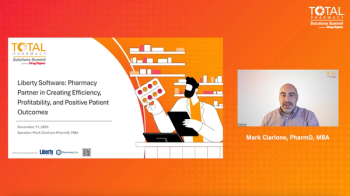
Dismantling Structural Racism in Pharmacy
At the HOPA Annual Conference 2021, Lakesha Butler, PharmD, BCCPS, discussed how pharmacists can disrupt the status quo to fight racism and work toward health equity for all.
Despite legal discrimination being outlawed almost 70 years ago, racism still exists today in various forms. Although it can look somewhat different from past days, its effects are similar and result in negative health disparities for minoritized groups.
During a keynote lecture at the Hematology/Oncology Pharmacy Association Annual Conference, which is being held virtually April 13 to 17, Lakesha Butler, PharmD, BCCPS, professor and director of diversity, equity, and inclusion at SIUE School of Pharmacy, in Edwardsville, Illinois, addressed how pharmacists can actively disrupt the status quo when it comes to structural racism.
“Groups that have been and continue to be subject of racism have seen it, have lived it, and have in fact died from it since its inception, and even today,” said Butler, who is also the CEO and co-founder of Dr. Lakesha Butler, LLC, and an editorial advisory board member of Drug Topics®.
Butler referred to 2020 as the “year of 2 pandemics.” The spotlighted racial injustices that have occurred over the past year brought many of these longstanding issues to the forefront. Moreover, data show that minority groups are disproportionately affected when it comes to COVID-19 outcomes. Black and African American individuals have a 2.1x higher mortality rate from COVID-19 compared with whites.
In many ways, the COVID-19 pandemic has shone a brighter light on racism today.
“However, unlike COVID-19 being a novel virus…racism is far from being novel and new,” said Butler.
According to Butler, these disproportionate health outcomes seen amid the pandemic are not simply the cause of any genetic or biological differences between groups, or individual choices made during the pandemic. Historical and contemporary racism impacting health care, housing, employment, and other social factors is to blame.
A History of Structural Racism: Understanding the “Why”
Most pharmacists and pharmacy students learn about topics in diversity, equity, and inclusion, as well as health care disparities affecting minority populations, but Butler argues that there is often a missing component to this education.
“An important piece that were oftentimes missing is the ‘why’,” Butler said. Education can often focus on the “what”: the data and statistics that represent persistent health care disparities between groups. However, according to Butler, it is crucial to peel back the layers in order to understand that these disparities are rooted in structural racism that still manifest today. Without this understanding, we run the risk of interpreting health disparities as facts unable to be changed, rather than as injustices that require interventions, she explained.
Furthermore, when we don’t recognize the why behind health care disparities affecting minorities, it can lead to associating cultural diversity with negative outcomes. “When hearing that certain groups are most likely to die from certain disease states, this further perpetuates the ideology that there’s something different about those individuals,” she explained.
The structural racism that fuels these disparities dates back to hundreds of years ago. Historically, specific laws and policies were used to separate individuals of color from those that are white. For example, Butler pointed to the subpar housing that was created for individuals of color, often built around toxic environments such as industrial plants. Minority communities were not given access to the same education, financial, or health care resources as whites. This created a system of inferiority, Butler said.
And although this discrimination is illegal today, the consequences of these policies have had lasting effects on minorities, according to Butler. She pointed specifically to continued segregation amongst minority groups in major cities, often resulting from a lack of financial means to move into certain neighborhoods. This dates back to not having the opportunities to build wealth or have certain jobs because of racist ideologies.
“Now we are about 70 years of having discrimination illegal,” Butler said. “We have a lot of work to do to dismantle the hundreds of years of structural racism.”
Social Determinants of Health
As it pertains to health care, the effects of structural racism on social determinants of health (SDOH) play an important role in the existing disparities.
“These differences are rooted in structural racism that are still manifested today,” Butler noted. She explained some of the social and economic factors, in addition to physical environmental factors, that affect individuals of color.
- Economic Stability: Employment, income, expenses, debt, medical bills, support
- Neighborhood and Physical Environment: Housing, transportation, safety, parks, playgrounds, walkability
- Education: Literacy, language, early childhood education, vocational training, higher education
- Food: Hunger, access to healthy options
- Community and Social Context: Social integration, support systems, community engagement, discrimination
- Health Care System: Health coverage, provider availability, provider linguistic and cultural competency, quality of care
Pharmacists should continue learning about areas of SDOH and consider these factors when caring for minority patients.
Steps to Dismantling Structural Racism
With all of this in mind, the question becomes “How do we dismantle structural racism?”
According to Butler, this starts with disrupting the status quo by getting to the root problem and working to address it. And although understanding SDOH is certainly a step in the process, it should not stop there. Addressing racism is both an organizational and individual responsibility.
Strategies for Organizations
Organizations can look to revise policies and practices to be more equitable, according to Butler.
“In organizations, what does your leadership look like? What about your hiring practices?” Butler said.
Engaging minoritized individuals as shared stakeholders is particularly important in creating a space for them to be heard. To do this, diversity, equity, and inclusion efforts are often employed in organizations. Butler stressed the importance of ensuring each of those terms are tied together.
For example, Butler explained that diversity can be termed as having a seat at the table, but not necessarily having your voice heard. Inclusion is the component that allows an individual to have a voice. The most important component is equity.
“Equity is where we allow the individuals to be heard,” Butler said.
When it comes to hiring practices, Butler recommends being intentional by reaching out to minorities when leadership opportunities arise. Minorities should be able to see themselves in leadership positions in organizations, she said. If the candidate pool isn’t diverse enough, Butler suggests coming up with a strategy to widen the pool and seek out proper representation before moving forward.
Strategies for the Individual
Butler recommends employing assessments to understand personal implicit biases. The Cycle of Socialization, for example, is an activity that can be used to understand how one helps to maintain an oppressive system based on the messages that have been taught regarding race.
“When we don’t know something, when we don’t dig deeper, we tend to fill in the blanks and make assumptions with the information we’ve been taught,” Butler said.
In addition to understanding and learning from personal biases, Butler emphasized the importance of become an active ally. This involves speaking up on behalf of minorities and becoming an educator in spaces that are often dominated by whiteness. “Allyship is a verb,” Butler stressed. “Moving from being a bystander to an ally is very important.”
As health care providers, it is also important to view patient encounters with an equity and trauma-informed care lens, according to Butler. Pharmacists should acknowledging racial injustices happening in different groups and how that is affecting the patient.
“We took an oath to make sure that we are providing the best care to all patients, all humanity,” Butler said. According to Butler, attaining equity for all patients is the ultimate goal.
“There will be times that you make mistakes…but I encourage you to get up, brush yourself off, and continue on this journey.”
Reference
- Butler L. Dismantling structural racism in pharmacy: Our individual and organizational responsibility. Presented at: Hematology/Oncology Pharmacy Association Annual Conference 2021; virtual; April 14, 2021.
Newsletter
Pharmacy practice is always changing. Stay ahead of the curve with the Drug Topics newsletter and get the latest drug information, industry trends, and patient care tips.











































































































































































































